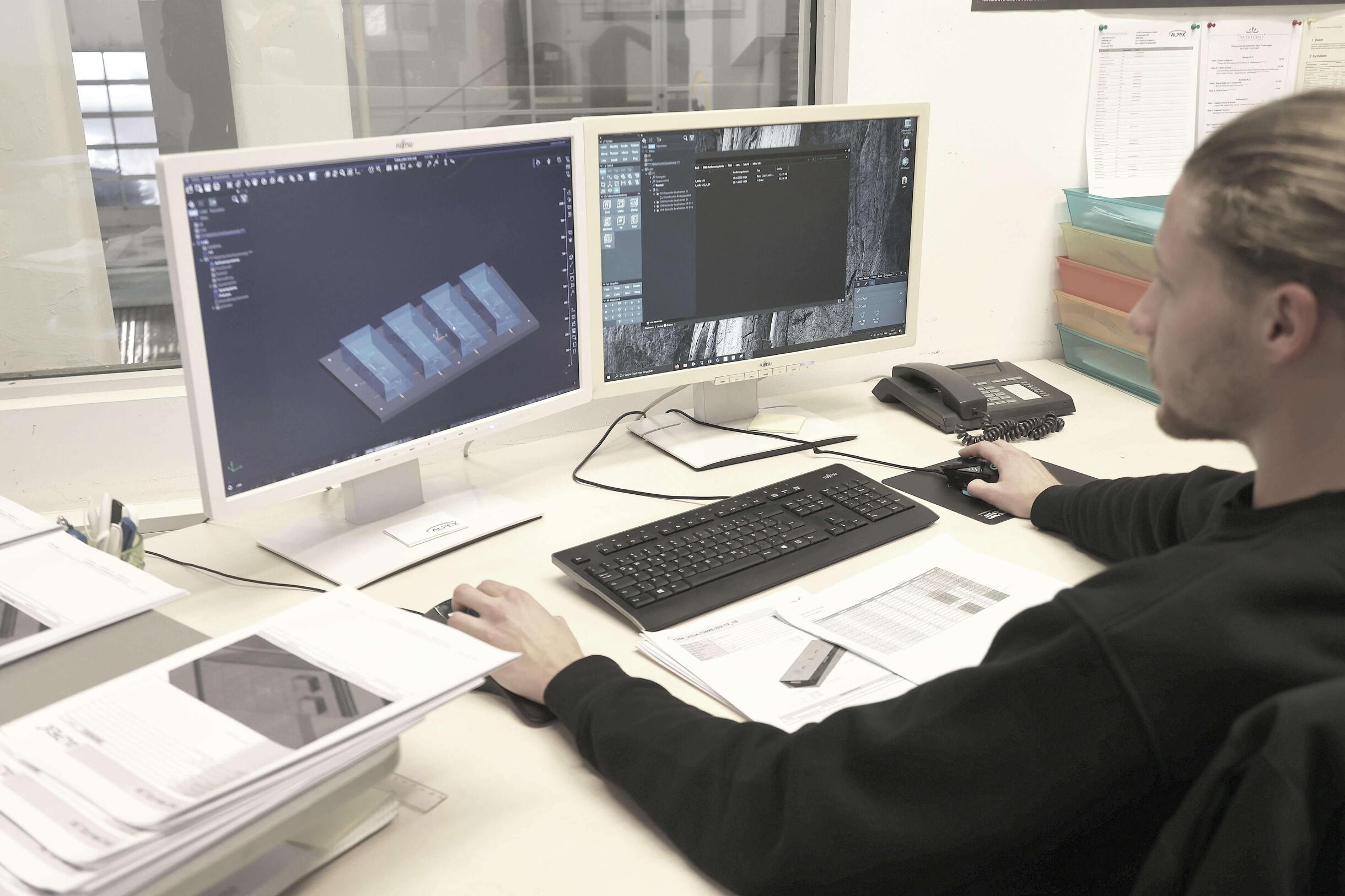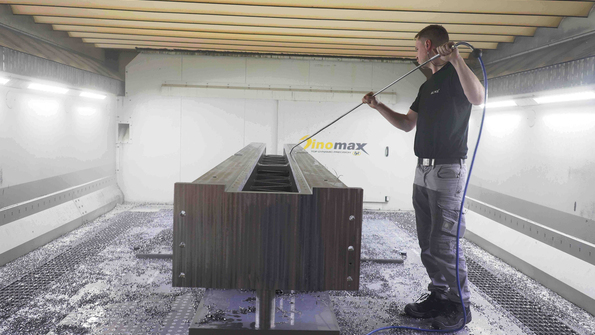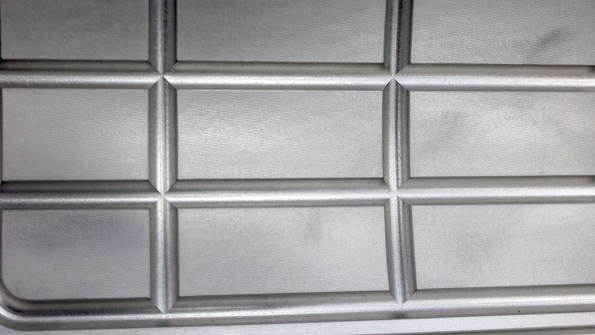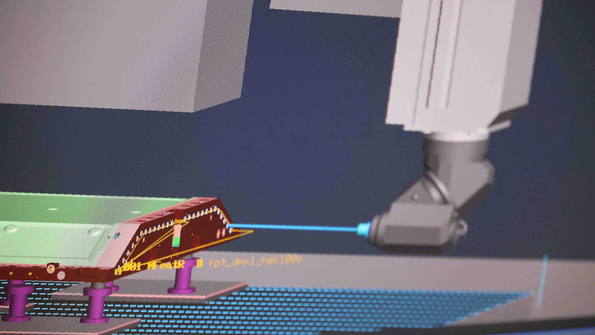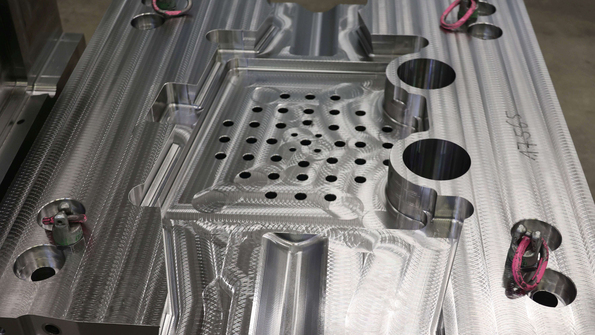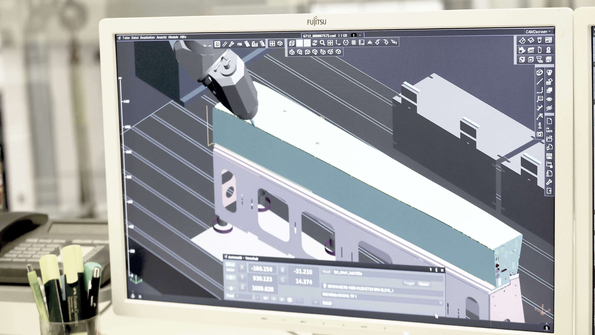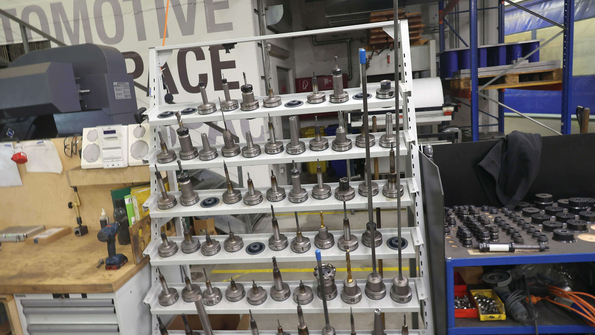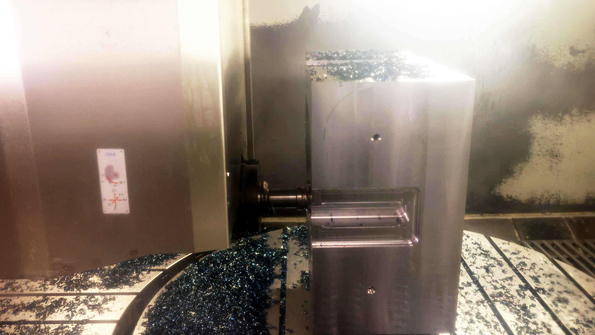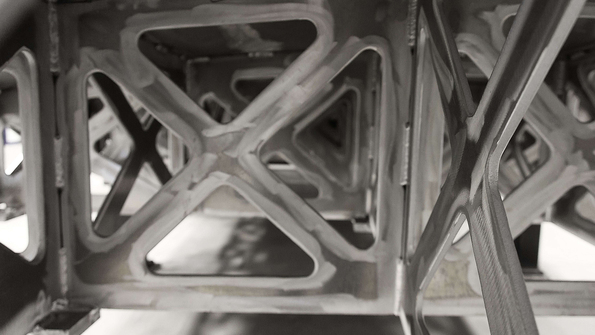Automated programming for complex dies and fixtures
The name Alpex is highly respected, especially in the aerospace industry. The innovative company frequently produces special and complex dies, molds and fixtures. The experts rely on the Tebis CAD/CAM package for design and programming. They’re already profiting greatly from the advantages of the new Tebis Version 4.1 for precise, cost-effective, and efficient production.
Company
Alpex Technologies GmbH
Focus
Alpex Technologies is a technology leader in the manufacture of innovative manufacturing systems for the industrial production of composite parts in industry sectors including aerospace, automotive, defense and general production machining.
Benefits:
- Tebis users gain a double speed advantage in 5-axis machining: With no additional design overhead, they can select multiple surfaces with a simple mouse-click and easily machine them with high-performance cycles on barrel cutters.
Published
2023
Interviewee: Christijan Narat, COO
At Alpex in Mils near Innsbruck, Austria, complex dies, molds and fixtures are produced primarily for the aerospace industry, and also for the automotive, defense and other industries. Nearly every part is unique, and the die, mold and fixture makers sometimes have to manufacture highly complex geometries. Some parts also have relatively large dimensions – the machinists can process up to 6 m in the X axis on their FPT machine. And the dies and fixtures also often require an outstanding surface finish: for example, on the surfaces that define the geometry.
Orders range from the form for an aircraft wing to highly automated RTM dies to individually manufactured clamping devices. All common tool steels are used, as well as other materials like Invar 36, an iron-nickel alloy that’s implemented due to its very low coefficient of thermal expansion, and plastics to a lesser extent.
Greater automation
Good personnel are also hard to find in Tyrol. With 50 employees, the company therefore relies on a high degree of automation. And this isn’t just for the machines in machining. "We’ve positioned ourselves to produce unique individual parts as intelligently, as quickly and as efficiently as possible," affirms Christijan Narat, COO at Alpex. "This is a true challenge, considering our wide range of parts. Because automation goes beyond the actual machines and also includes creating the programs."
Admittedly, the parts and components manufactured for customers are usually single items. "But the way workpieces are machined is repeated over and over – so classes of workpieces can be grouped for similar machining using machining sequences that are similar or even the same. And these can also be similarly programmed."The experts at Alpex have relied on the Tebis CAD/CAM package since 2014, and they now the current Version 4.1. "This isn’t just due to the outstanding quality of the software and its endless possibilities," says Narat. "We have a partner in Tebis who also provides us with advice and support for our everyday challenges. Fast, safe and competent."
The components are processed on seven machines. The machine pool includes a FPT Dinomax 5-axis high-speed milling machine with integrated linear drive technology and a machining size of 6,000 x 3,500 mm, plus an AXA VPC-U gantry machining center, also with five axes. These machines combine ample roughing performance with high precision for finishing.Machining dominated by free-form surfaces
"Our fixtures and clamping devices that we manufacture for aerospace projects for premium manufacturers around the world often feature free-form surfaces," Narat explains. "Some workpieces have hardly any right angles or flat surfaces at all. 5-axis simultaneous machining is the rule for us. Tebis supports us in this context with intelligent functions for streamlined programming of these features."
For Narat, less is often more in programming: "Since the switch to V4.1, we need significantly fewer tools and resources to fully utilize our seven machines, he says. "We’ve been able to eliminate previously mandatory work steps and save time, thanks to the sophisticated NCSets from Tebis. This now allows us to make more efficient use of our specialists' capacity."
Automated programming of similar parts
The NCSets, also known as NC templates, enable automated programming of recurring features and procedures. "The designer can prepare each workpiece with data in the CAD system," Narat explains. "Parametric design starts in CAD. The employee has to position holes for clamping systems and define the relevant clamping points, fill surfaces, configure blanks, position clamping devices and much more. The generation of raw data can be controlled very well with parameters."
This was unpopular and routine work that also traditionally required a lot of manual programming. "What's really great: Tebis can program these many individual steps automatically with the NCSets,” the plant manager adds. "The programmer is less stressed, and the nerve-racking work of manually preparing individual features is almost completely eliminated. This frees up creative minds for more important work."
Significant savings in programming time
Narat finds that parametric design has again improved significantly in the new Version 4.1. "In a current order for 30 dies that are all different, for example, the clamping situation for the workpieces is still very similar," the production expert explains. "Thanks to our detailed NC libraries that we prepared with the Tebis specialists, the programmer essentially only has to 'marry' the parameters from the database with the geometries. These functions, save us roughly 20 minutes of programming time in preparing a die half."
With roughly 400 die halves to be programmed in a year, this savings alone adds up to more than 130 work-hours. "This is time that we can put to good use elsewhere," Narat emphasizes. "We’re making very extensive use of the optimization and automation options in the new Tebis 4.1. Our programming capacity now enables us to optimally utilize our machines in two shifts with operators and unattended at night and on weekends.”
Finished programs go directly to the machine
Where a lot of "manual labor" was previously required to get a program onto the machine on-site, this has also undergone a fundamental change. When the programs come out of CAM programming, they’re high-quality and are ready, refined and directly executable on the respective machining center. There’s no longer a need for adjustments on the machine by the employee on-site.
The other features of Tebis 4.1 also enable streamlined, efficient manufacturing. For example, the new version includes highly efficient cycles for barrel cutters. The Alpex machinists first used this for a large rush order. "The structures in this job were up to 5 m long," Narat says. "This entails a lot of milling work. In order to quickly achieve this goal, we first took an entire week – though it might sound paradoxical – to research and evaluate the optimal milling strategy for our FPT machine."
Highly effective machining with barrel cutters
The final decision was for a barrel cutter, which could machine the part significantly faster and more effectively than the ball cutters normally used. "Tebis 4.1 provides us high-performance cycles for barrel cutters," says the operations manager. "This allowed us to handily cut the milling time in half, which paid for itself considering the size of the part, and our customer was pleased."
And since surface quality was also significantly improved, the Tyroleans were also able to reduce the reworking (polishing) to a third of the time. As a result of this process, the barrel cutter also supports shorter setups than classic end flat cutters. This also enables more precise and safe work.
Deep hole drilling largely unattended
The cycles for deep hole drilling also proved to be a great advantage in processing the large order. "We've already been using those since Version 4.0, but they've been improved even more," explains Narat. "We had to drill a large number of holes with a diameter of 20 mm to a depth of up to 1,300 mm on our FPT machine in seven large dies with mold plates of up to 3.5 x 3 m. The sophisticated deep drilling cycles allowed us to process the pilot drilling and drilling to a depth of up to 1,000 mm completely unattended. This saved us two work-shifts per die. And we were able to transfer a lot of the work over to unattended nights and weekends.”
Considering the large workpieces and the often expensive blanks, it’s all the more important that the machinists be able to rely 100 percent on smooth, safe and stable processing by the programs, even during unattended operation. "That’s why we consistently use the highly extensive simulation options in Tebis 4.1," Narat affirms. "No program goes to the machine without first being simulated."
Data quality is critical
However, a simulation can only be as good as the quality of the data supplied to it. "If a programmer sees that he still has a few millimeters of clearance in a machining operation, he'll use it if necessary," the experienced operations manager says. "For example, if a wall isn’t positioned in the machine as precisely as in the digital twin provided by default, a crash is inevitable at some point. Experts from Tebis therefore precisely remeasured our machines and compared them with the existing digital twins. And we worked together to define the resulting safety distances – so that we really can machine optimally."
The actual data for the clamping devices used at Alpex are also precisely registered and stored in detailed libraries. And the geometry data for the tools comes directly from the tool presets in the Zoller device. The employees working on the machine take utmost care to ensure that they set up the part precisely in accordance with the setup plan and that the situation on the machine therefore also corresponds to the digital data. "This lets us be confident that our collision-checked programs will also run safely, even in unattended operation," Narat explains. "And with optimal parameters and a potentiometer setting of 100 percent. Our crash rate has dropped to a level we can ignore."
Service is an immensely important factor
In addition to its sophisticated programs, Tebis also provides expert consulting and excellent service. The machinists make regular use of this option. "When we call the hotline, we immediately have experts on the line who understand and consider our concerns and work with us to develop viable solutions for the challenges we face in our everyday work," says Narat. "We’re certainly not the largest Tebis user. But we have a good feeling that Tebis takes us seriously. The experts there are ambitious about creating solutions that are optimal for us."
The Tyroleans also appreciate the experience, knowledge and expertise of the software provider. "We treat ourselves to trainings at Tebis from time to time," Narat says. "We receive training at our site that’s customized for our specific needs. We submit our requests in advance, and the Tebis experts prepare the topics and come to us. We can therefore be sure that we receive training and quality consulting that are optimally suited to our needs, which are often very special due to our part spectrum. More than anything else, it's this outstanding collaboration that makes the relationship with Tebis a real and highly effective partnership on an equal footing.” Richard Pergler
Alpex Technologies
Alpex Technologies is a technology leader in the manufacture of innovative manufacturing systems for the industrial production of composite parts in industry sectors including aerospace, automotive, defense and general production machining. Company experts are continuously working on new research and development projects. They’re therefore making a significant contribution to the digitalization of composite manufacturing processes. Alpex Technologies also plays a leading role in the development of technologies for manufacturing BIO composite parts.
Strategies for barrel cutters
The radii in the cutting area are significantly larger on barrel cutters (circle-segment cutters) than on conventional ball cutters. The user can use these tools for highly efficient prefinishing and finishing of planar and free-form surfaces. These tools achieve a consistent cusp height on the part surface with a significantly larger path distance. They can also significantly reduce machining time while maintaining high surface quality. Barrel cutters are suitable for both 3-axis tilted machining as well as 5-axis simultaneous machining. Tebis users gain a double speed advantage in 5-axis machining: With no additional design overhead, they can select multiple surfaces with a simple mouse-click and easily machine them with high-performance cycles on barrel cutters.
The human factor makes the difference
Tebis's sophisticated CAD/CAM package is a high-end solution for designing and programming even highly complex parts. HHowever, its NCSets also make it an intelligent and efficient solution for fast, convenient and optimal production. The software is one aspect – but every bit as important to the Alpex professionals are the expert contacts at Tebis who can help them quickly and skillfully with the day-to-day challenges of their work. It becomes clear in speaking with those responsible that the excellent support is a key factor for them in favor of Tebis. It is the people, their skills and especially their willingness to commit themselves to the users that make the critical difference.
Richard Pergler



